Anatomy and Physiology Question Answer 2022
VerifiedAdded on 2022/10/19
|9
|2370
|34
AI Summary
Contribute Materials
Your contribution can guide someone’s learning journey. Share your
documents today.
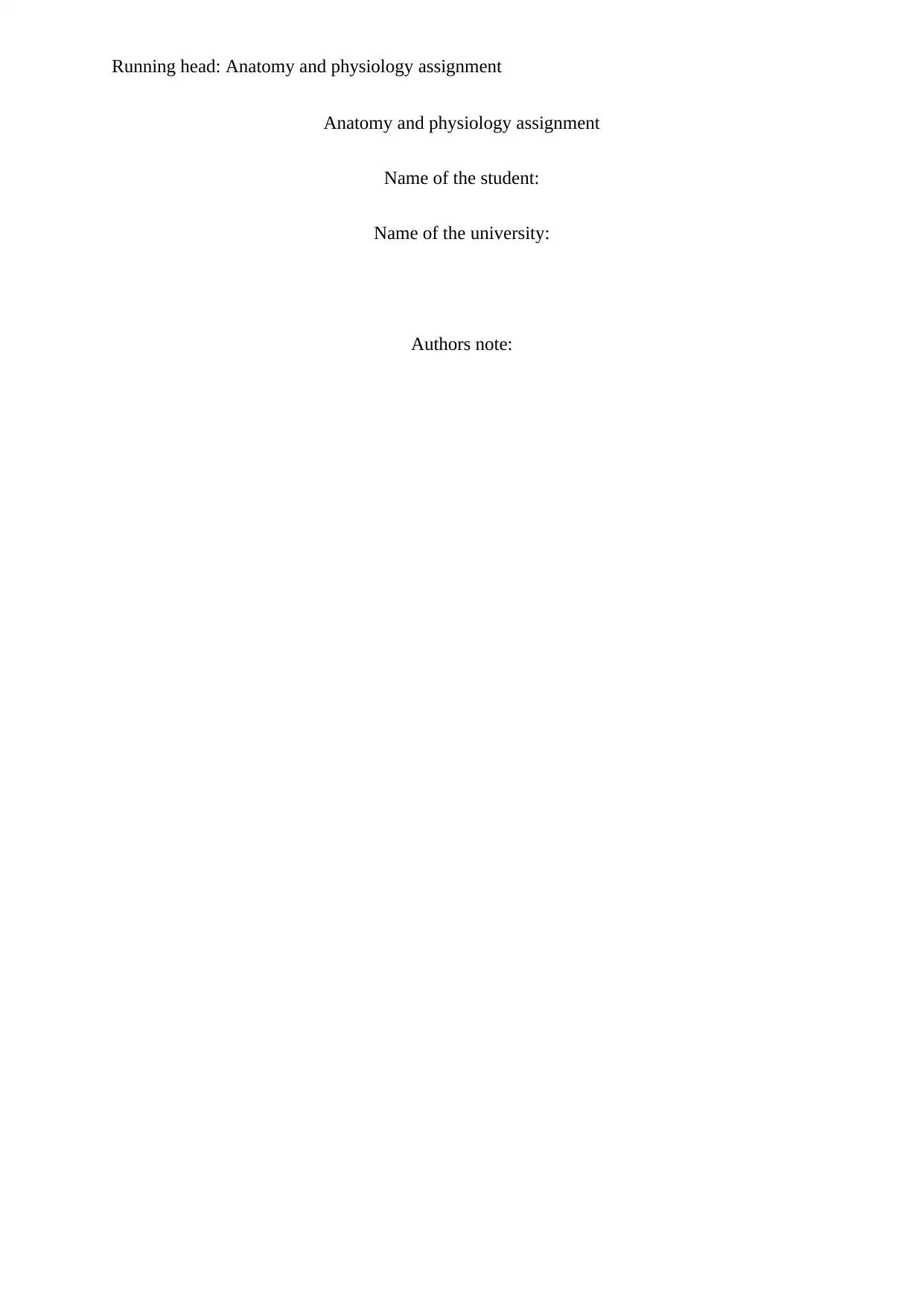
Running head: Anatomy and physiology assignment
Anatomy and physiology assignment
Name of the student:
Name of the university:
Authors note:
Anatomy and physiology assignment
Name of the student:
Name of the university:
Authors note:
Secure Best Marks with AI Grader
Need help grading? Try our AI Grader for instant feedback on your assignments.
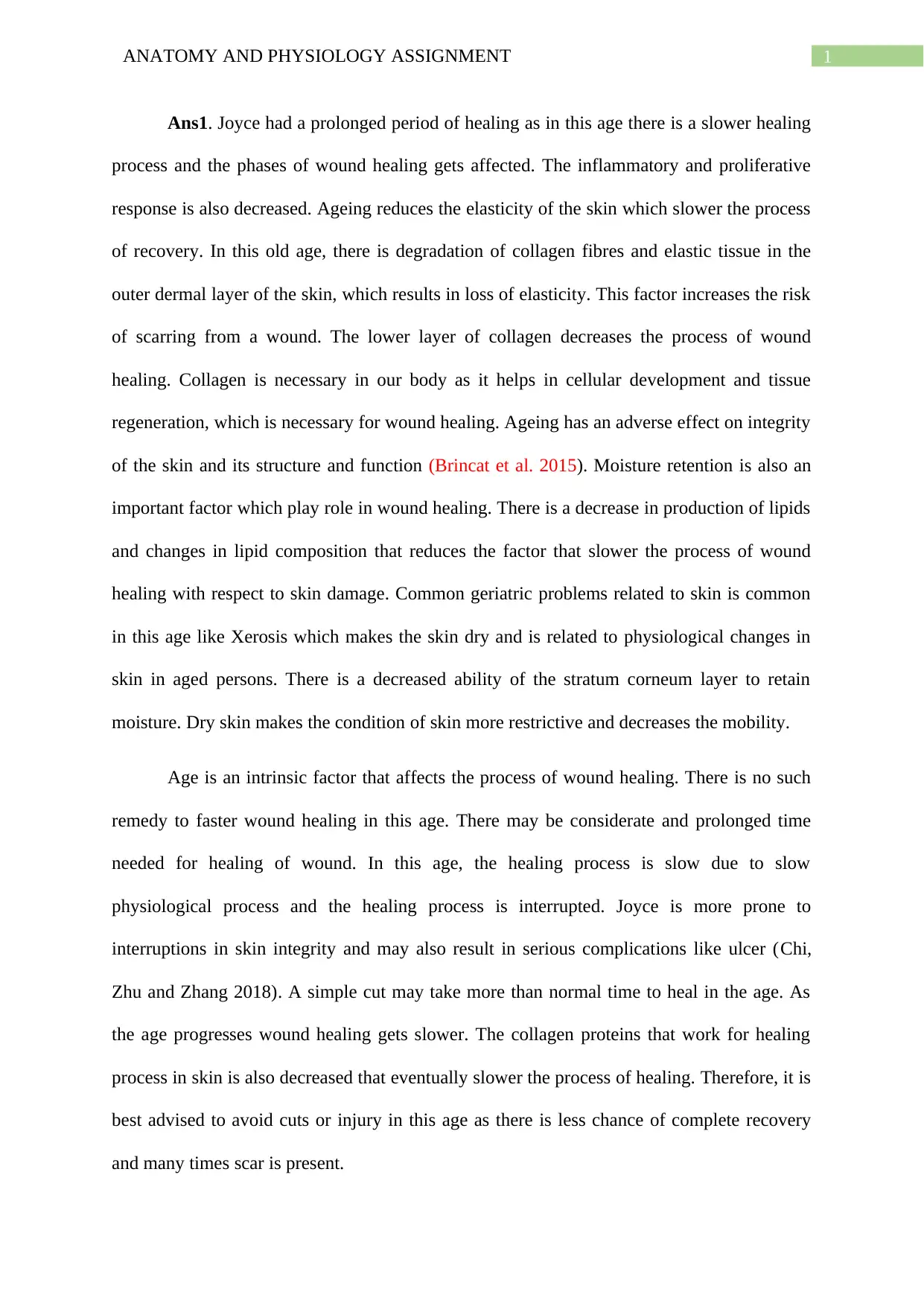
1ANATOMY AND PHYSIOLOGY ASSIGNMENT
Ans1. Joyce had a prolonged period of healing as in this age there is a slower healing
process and the phases of wound healing gets affected. The inflammatory and proliferative
response is also decreased. Ageing reduces the elasticity of the skin which slower the process
of recovery. In this old age, there is degradation of collagen fibres and elastic tissue in the
outer dermal layer of the skin, which results in loss of elasticity. This factor increases the risk
of scarring from a wound. The lower layer of collagen decreases the process of wound
healing. Collagen is necessary in our body as it helps in cellular development and tissue
regeneration, which is necessary for wound healing. Ageing has an adverse effect on integrity
of the skin and its structure and function (Brincat et al. 2015). Moisture retention is also an
important factor which play role in wound healing. There is a decrease in production of lipids
and changes in lipid composition that reduces the factor that slower the process of wound
healing with respect to skin damage. Common geriatric problems related to skin is common
in this age like Xerosis which makes the skin dry and is related to physiological changes in
skin in aged persons. There is a decreased ability of the stratum corneum layer to retain
moisture. Dry skin makes the condition of skin more restrictive and decreases the mobility.
Age is an intrinsic factor that affects the process of wound healing. There is no such
remedy to faster wound healing in this age. There may be considerate and prolonged time
needed for healing of wound. In this age, the healing process is slow due to slow
physiological process and the healing process is interrupted. Joyce is more prone to
interruptions in skin integrity and may also result in serious complications like ulcer (Chi,
Zhu and Zhang 2018). A simple cut may take more than normal time to heal in the age. As
the age progresses wound healing gets slower. The collagen proteins that work for healing
process in skin is also decreased that eventually slower the process of healing. Therefore, it is
best advised to avoid cuts or injury in this age as there is less chance of complete recovery
and many times scar is present.
Ans1. Joyce had a prolonged period of healing as in this age there is a slower healing
process and the phases of wound healing gets affected. The inflammatory and proliferative
response is also decreased. Ageing reduces the elasticity of the skin which slower the process
of recovery. In this old age, there is degradation of collagen fibres and elastic tissue in the
outer dermal layer of the skin, which results in loss of elasticity. This factor increases the risk
of scarring from a wound. The lower layer of collagen decreases the process of wound
healing. Collagen is necessary in our body as it helps in cellular development and tissue
regeneration, which is necessary for wound healing. Ageing has an adverse effect on integrity
of the skin and its structure and function (Brincat et al. 2015). Moisture retention is also an
important factor which play role in wound healing. There is a decrease in production of lipids
and changes in lipid composition that reduces the factor that slower the process of wound
healing with respect to skin damage. Common geriatric problems related to skin is common
in this age like Xerosis which makes the skin dry and is related to physiological changes in
skin in aged persons. There is a decreased ability of the stratum corneum layer to retain
moisture. Dry skin makes the condition of skin more restrictive and decreases the mobility.
Age is an intrinsic factor that affects the process of wound healing. There is no such
remedy to faster wound healing in this age. There may be considerate and prolonged time
needed for healing of wound. In this age, the healing process is slow due to slow
physiological process and the healing process is interrupted. Joyce is more prone to
interruptions in skin integrity and may also result in serious complications like ulcer (Chi,
Zhu and Zhang 2018). A simple cut may take more than normal time to heal in the age. As
the age progresses wound healing gets slower. The collagen proteins that work for healing
process in skin is also decreased that eventually slower the process of healing. Therefore, it is
best advised to avoid cuts or injury in this age as there is less chance of complete recovery
and many times scar is present.
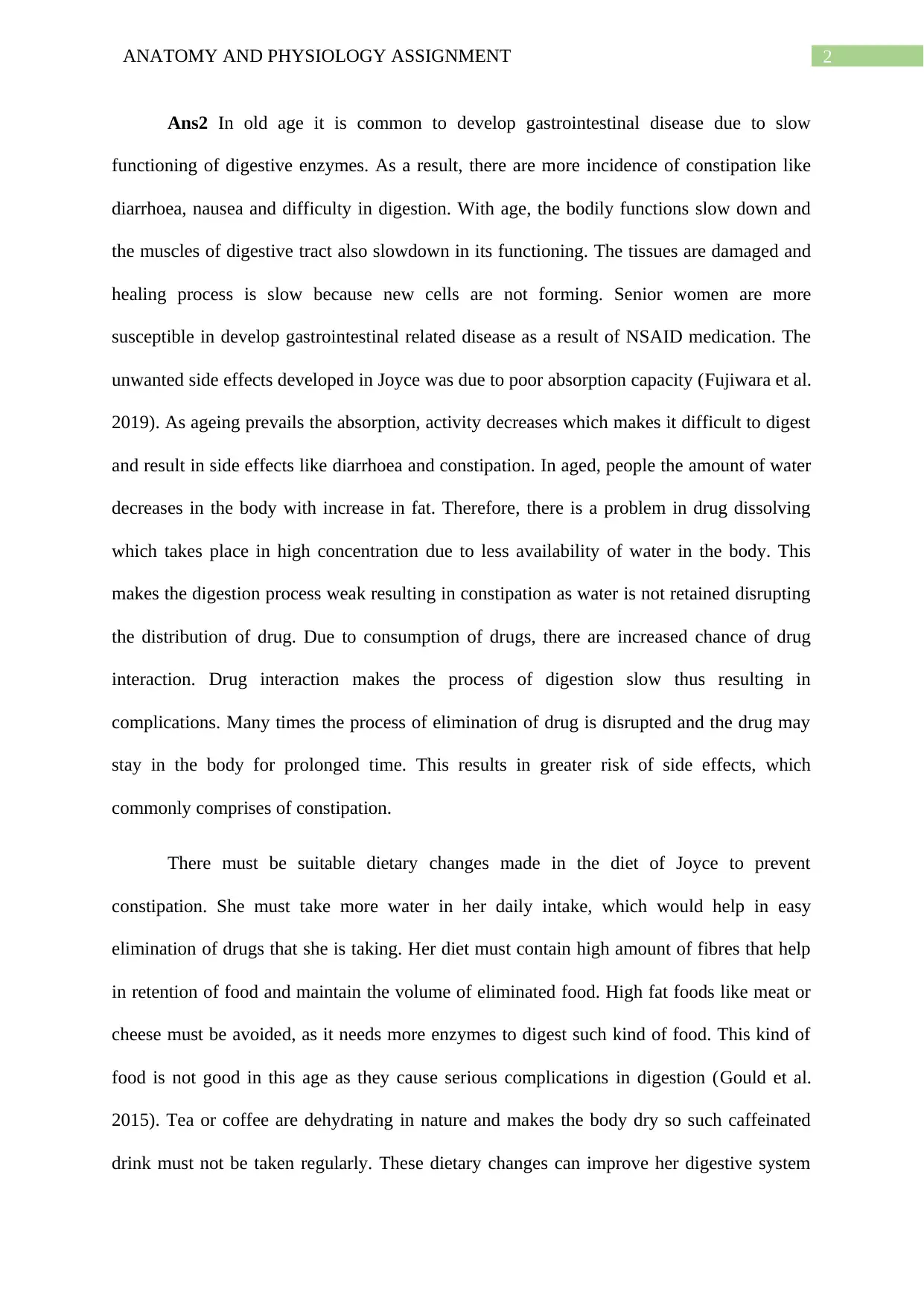
2ANATOMY AND PHYSIOLOGY ASSIGNMENT
Ans2 In old age it is common to develop gastrointestinal disease due to slow
functioning of digestive enzymes. As a result, there are more incidence of constipation like
diarrhoea, nausea and difficulty in digestion. With age, the bodily functions slow down and
the muscles of digestive tract also slowdown in its functioning. The tissues are damaged and
healing process is slow because new cells are not forming. Senior women are more
susceptible in develop gastrointestinal related disease as a result of NSAID medication. The
unwanted side effects developed in Joyce was due to poor absorption capacity (Fujiwara et al.
2019). As ageing prevails the absorption, activity decreases which makes it difficult to digest
and result in side effects like diarrhoea and constipation. In aged, people the amount of water
decreases in the body with increase in fat. Therefore, there is a problem in drug dissolving
which takes place in high concentration due to less availability of water in the body. This
makes the digestion process weak resulting in constipation as water is not retained disrupting
the distribution of drug. Due to consumption of drugs, there are increased chance of drug
interaction. Drug interaction makes the process of digestion slow thus resulting in
complications. Many times the process of elimination of drug is disrupted and the drug may
stay in the body for prolonged time. This results in greater risk of side effects, which
commonly comprises of constipation.
There must be suitable dietary changes made in the diet of Joyce to prevent
constipation. She must take more water in her daily intake, which would help in easy
elimination of drugs that she is taking. Her diet must contain high amount of fibres that help
in retention of food and maintain the volume of eliminated food. High fat foods like meat or
cheese must be avoided, as it needs more enzymes to digest such kind of food. This kind of
food is not good in this age as they cause serious complications in digestion (Gould et al.
2015). Tea or coffee are dehydrating in nature and makes the body dry so such caffeinated
drink must not be taken regularly. These dietary changes can improve her digestive system
Ans2 In old age it is common to develop gastrointestinal disease due to slow
functioning of digestive enzymes. As a result, there are more incidence of constipation like
diarrhoea, nausea and difficulty in digestion. With age, the bodily functions slow down and
the muscles of digestive tract also slowdown in its functioning. The tissues are damaged and
healing process is slow because new cells are not forming. Senior women are more
susceptible in develop gastrointestinal related disease as a result of NSAID medication. The
unwanted side effects developed in Joyce was due to poor absorption capacity (Fujiwara et al.
2019). As ageing prevails the absorption, activity decreases which makes it difficult to digest
and result in side effects like diarrhoea and constipation. In aged, people the amount of water
decreases in the body with increase in fat. Therefore, there is a problem in drug dissolving
which takes place in high concentration due to less availability of water in the body. This
makes the digestion process weak resulting in constipation as water is not retained disrupting
the distribution of drug. Due to consumption of drugs, there are increased chance of drug
interaction. Drug interaction makes the process of digestion slow thus resulting in
complications. Many times the process of elimination of drug is disrupted and the drug may
stay in the body for prolonged time. This results in greater risk of side effects, which
commonly comprises of constipation.
There must be suitable dietary changes made in the diet of Joyce to prevent
constipation. She must take more water in her daily intake, which would help in easy
elimination of drugs that she is taking. Her diet must contain high amount of fibres that help
in retention of food and maintain the volume of eliminated food. High fat foods like meat or
cheese must be avoided, as it needs more enzymes to digest such kind of food. This kind of
food is not good in this age as they cause serious complications in digestion (Gould et al.
2015). Tea or coffee are dehydrating in nature and makes the body dry so such caffeinated
drink must not be taken regularly. These dietary changes can improve her digestive system
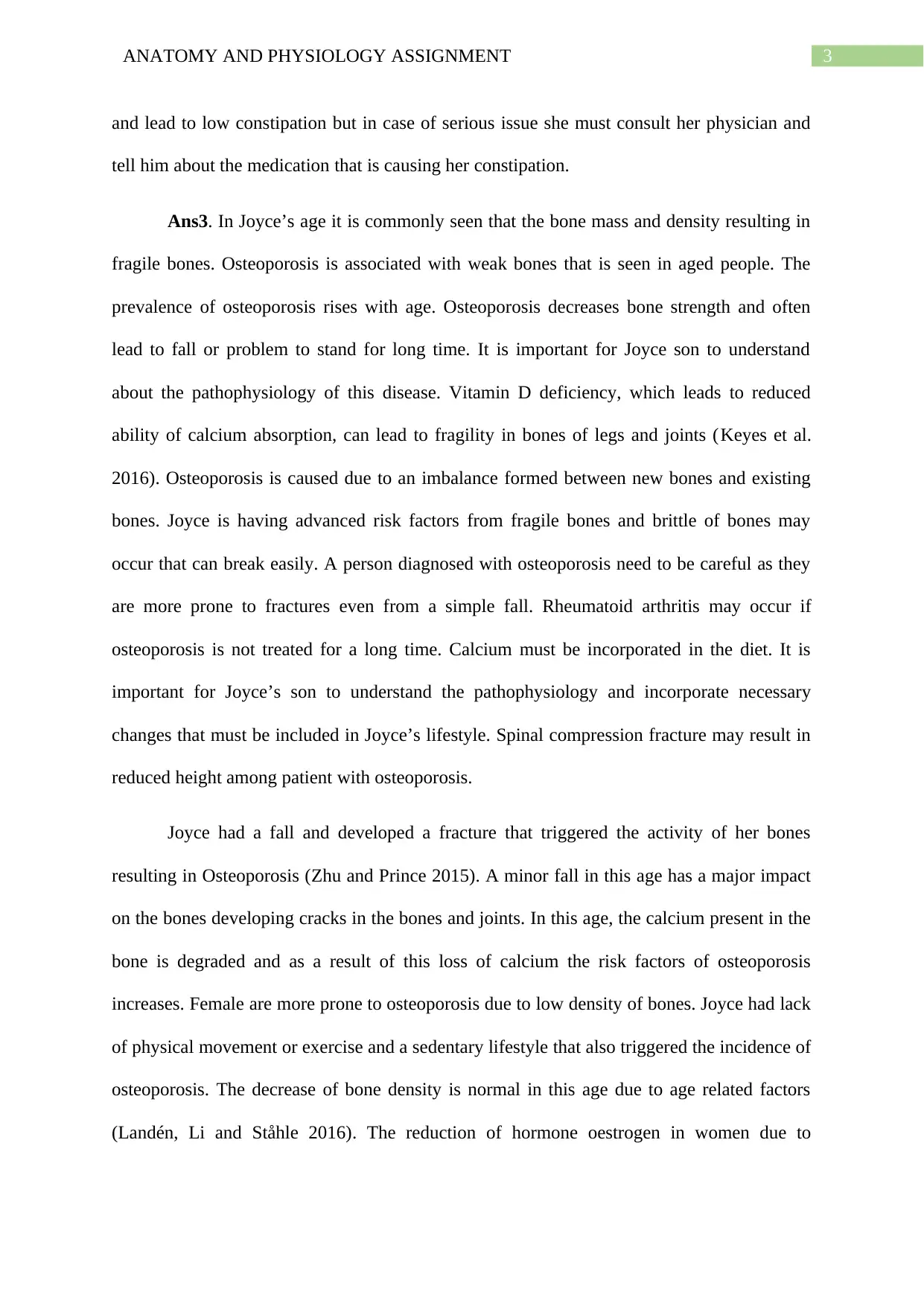
3ANATOMY AND PHYSIOLOGY ASSIGNMENT
and lead to low constipation but in case of serious issue she must consult her physician and
tell him about the medication that is causing her constipation.
Ans3. In Joyce’s age it is commonly seen that the bone mass and density resulting in
fragile bones. Osteoporosis is associated with weak bones that is seen in aged people. The
prevalence of osteoporosis rises with age. Osteoporosis decreases bone strength and often
lead to fall or problem to stand for long time. It is important for Joyce son to understand
about the pathophysiology of this disease. Vitamin D deficiency, which leads to reduced
ability of calcium absorption, can lead to fragility in bones of legs and joints (Keyes et al.
2016). Osteoporosis is caused due to an imbalance formed between new bones and existing
bones. Joyce is having advanced risk factors from fragile bones and brittle of bones may
occur that can break easily. A person diagnosed with osteoporosis need to be careful as they
are more prone to fractures even from a simple fall. Rheumatoid arthritis may occur if
osteoporosis is not treated for a long time. Calcium must be incorporated in the diet. It is
important for Joyce’s son to understand the pathophysiology and incorporate necessary
changes that must be included in Joyce’s lifestyle. Spinal compression fracture may result in
reduced height among patient with osteoporosis.
Joyce had a fall and developed a fracture that triggered the activity of her bones
resulting in Osteoporosis (Zhu and Prince 2015). A minor fall in this age has a major impact
on the bones developing cracks in the bones and joints. In this age, the calcium present in the
bone is degraded and as a result of this loss of calcium the risk factors of osteoporosis
increases. Female are more prone to osteoporosis due to low density of bones. Joyce had lack
of physical movement or exercise and a sedentary lifestyle that also triggered the incidence of
osteoporosis. The decrease of bone density is normal in this age due to age related factors
(Landén, Li and Ståhle 2016). The reduction of hormone oestrogen in women due to
and lead to low constipation but in case of serious issue she must consult her physician and
tell him about the medication that is causing her constipation.
Ans3. In Joyce’s age it is commonly seen that the bone mass and density resulting in
fragile bones. Osteoporosis is associated with weak bones that is seen in aged people. The
prevalence of osteoporosis rises with age. Osteoporosis decreases bone strength and often
lead to fall or problem to stand for long time. It is important for Joyce son to understand
about the pathophysiology of this disease. Vitamin D deficiency, which leads to reduced
ability of calcium absorption, can lead to fragility in bones of legs and joints (Keyes et al.
2016). Osteoporosis is caused due to an imbalance formed between new bones and existing
bones. Joyce is having advanced risk factors from fragile bones and brittle of bones may
occur that can break easily. A person diagnosed with osteoporosis need to be careful as they
are more prone to fractures even from a simple fall. Rheumatoid arthritis may occur if
osteoporosis is not treated for a long time. Calcium must be incorporated in the diet. It is
important for Joyce’s son to understand the pathophysiology and incorporate necessary
changes that must be included in Joyce’s lifestyle. Spinal compression fracture may result in
reduced height among patient with osteoporosis.
Joyce had a fall and developed a fracture that triggered the activity of her bones
resulting in Osteoporosis (Zhu and Prince 2015). A minor fall in this age has a major impact
on the bones developing cracks in the bones and joints. In this age, the calcium present in the
bone is degraded and as a result of this loss of calcium the risk factors of osteoporosis
increases. Female are more prone to osteoporosis due to low density of bones. Joyce had lack
of physical movement or exercise and a sedentary lifestyle that also triggered the incidence of
osteoporosis. The decrease of bone density is normal in this age due to age related factors
(Landén, Li and Ståhle 2016). The reduction of hormone oestrogen in women due to
Secure Best Marks with AI Grader
Need help grading? Try our AI Grader for instant feedback on your assignments.
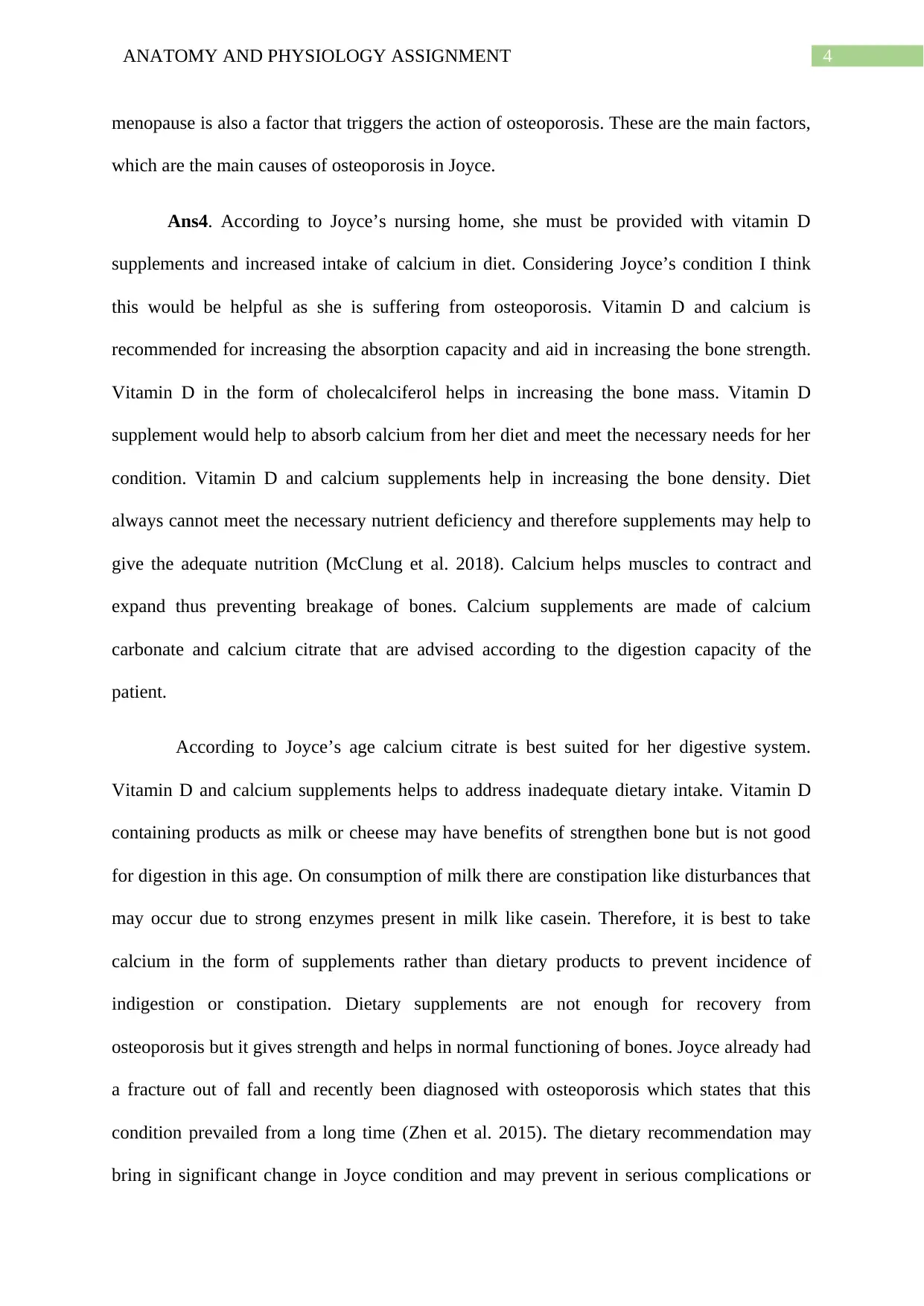
4ANATOMY AND PHYSIOLOGY ASSIGNMENT
menopause is also a factor that triggers the action of osteoporosis. These are the main factors,
which are the main causes of osteoporosis in Joyce.
Ans4. According to Joyce’s nursing home, she must be provided with vitamin D
supplements and increased intake of calcium in diet. Considering Joyce’s condition I think
this would be helpful as she is suffering from osteoporosis. Vitamin D and calcium is
recommended for increasing the absorption capacity and aid in increasing the bone strength.
Vitamin D in the form of cholecalciferol helps in increasing the bone mass. Vitamin D
supplement would help to absorb calcium from her diet and meet the necessary needs for her
condition. Vitamin D and calcium supplements help in increasing the bone density. Diet
always cannot meet the necessary nutrient deficiency and therefore supplements may help to
give the adequate nutrition (McClung et al. 2018). Calcium helps muscles to contract and
expand thus preventing breakage of bones. Calcium supplements are made of calcium
carbonate and calcium citrate that are advised according to the digestion capacity of the
patient.
According to Joyce’s age calcium citrate is best suited for her digestive system.
Vitamin D and calcium supplements helps to address inadequate dietary intake. Vitamin D
containing products as milk or cheese may have benefits of strengthen bone but is not good
for digestion in this age. On consumption of milk there are constipation like disturbances that
may occur due to strong enzymes present in milk like casein. Therefore, it is best to take
calcium in the form of supplements rather than dietary products to prevent incidence of
indigestion or constipation. Dietary supplements are not enough for recovery from
osteoporosis but it gives strength and helps in normal functioning of bones. Joyce already had
a fracture out of fall and recently been diagnosed with osteoporosis which states that this
condition prevailed from a long time (Zhen et al. 2015). The dietary recommendation may
bring in significant change in Joyce condition and may prevent in serious complications or
menopause is also a factor that triggers the action of osteoporosis. These are the main factors,
which are the main causes of osteoporosis in Joyce.
Ans4. According to Joyce’s nursing home, she must be provided with vitamin D
supplements and increased intake of calcium in diet. Considering Joyce’s condition I think
this would be helpful as she is suffering from osteoporosis. Vitamin D and calcium is
recommended for increasing the absorption capacity and aid in increasing the bone strength.
Vitamin D in the form of cholecalciferol helps in increasing the bone mass. Vitamin D
supplement would help to absorb calcium from her diet and meet the necessary needs for her
condition. Vitamin D and calcium supplements help in increasing the bone density. Diet
always cannot meet the necessary nutrient deficiency and therefore supplements may help to
give the adequate nutrition (McClung et al. 2018). Calcium helps muscles to contract and
expand thus preventing breakage of bones. Calcium supplements are made of calcium
carbonate and calcium citrate that are advised according to the digestion capacity of the
patient.
According to Joyce’s age calcium citrate is best suited for her digestive system.
Vitamin D and calcium supplements helps to address inadequate dietary intake. Vitamin D
containing products as milk or cheese may have benefits of strengthen bone but is not good
for digestion in this age. On consumption of milk there are constipation like disturbances that
may occur due to strong enzymes present in milk like casein. Therefore, it is best to take
calcium in the form of supplements rather than dietary products to prevent incidence of
indigestion or constipation. Dietary supplements are not enough for recovery from
osteoporosis but it gives strength and helps in normal functioning of bones. Joyce already had
a fracture out of fall and recently been diagnosed with osteoporosis which states that this
condition prevailed from a long time (Zhen et al. 2015). The dietary recommendation may
bring in significant change in Joyce condition and may prevent in serious complications or
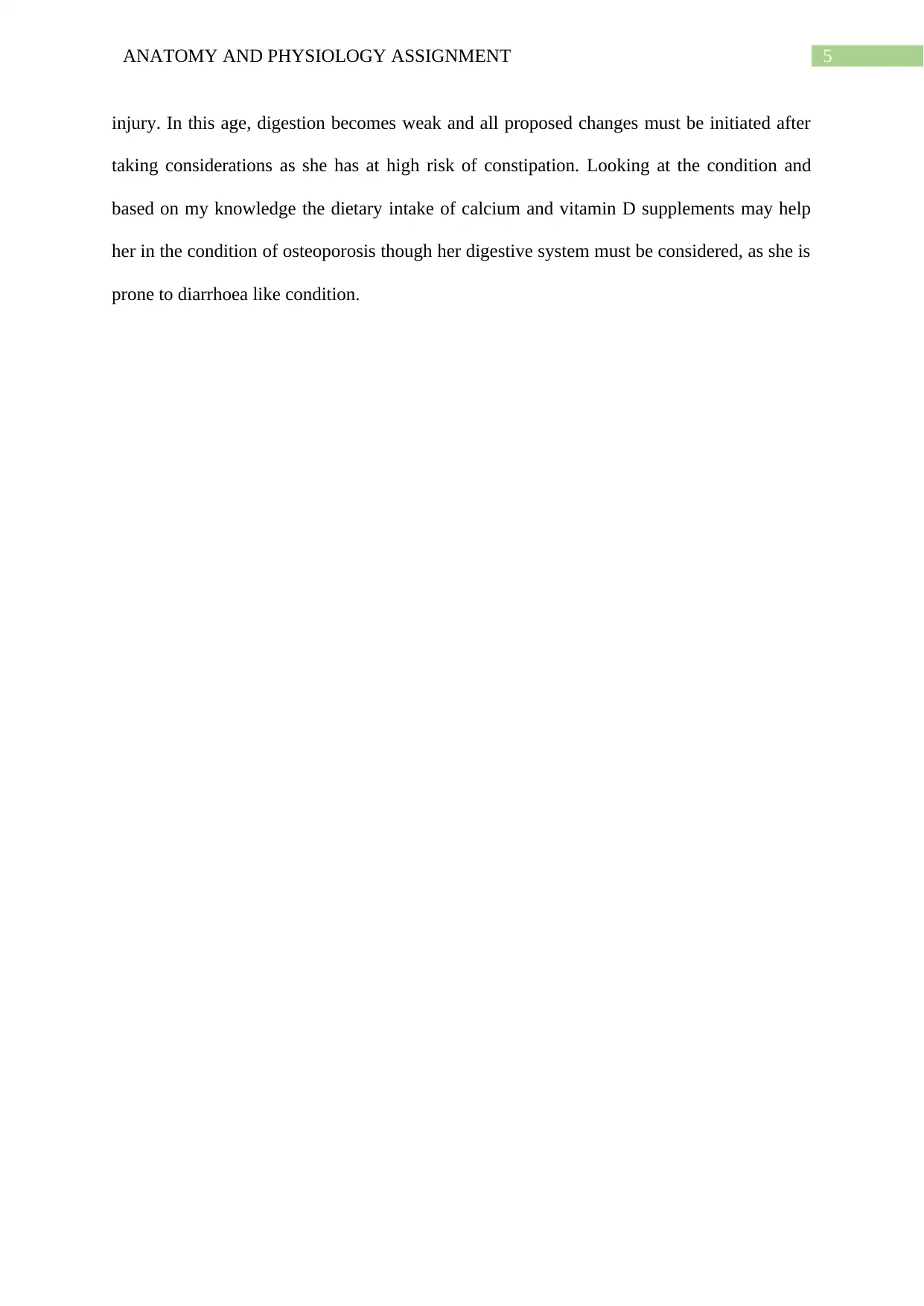
5ANATOMY AND PHYSIOLOGY ASSIGNMENT
injury. In this age, digestion becomes weak and all proposed changes must be initiated after
taking considerations as she has at high risk of constipation. Looking at the condition and
based on my knowledge the dietary intake of calcium and vitamin D supplements may help
her in the condition of osteoporosis though her digestive system must be considered, as she is
prone to diarrhoea like condition.
injury. In this age, digestion becomes weak and all proposed changes must be initiated after
taking considerations as she has at high risk of constipation. Looking at the condition and
based on my knowledge the dietary intake of calcium and vitamin D supplements may help
her in the condition of osteoporosis though her digestive system must be considered, as she is
prone to diarrhoea like condition.
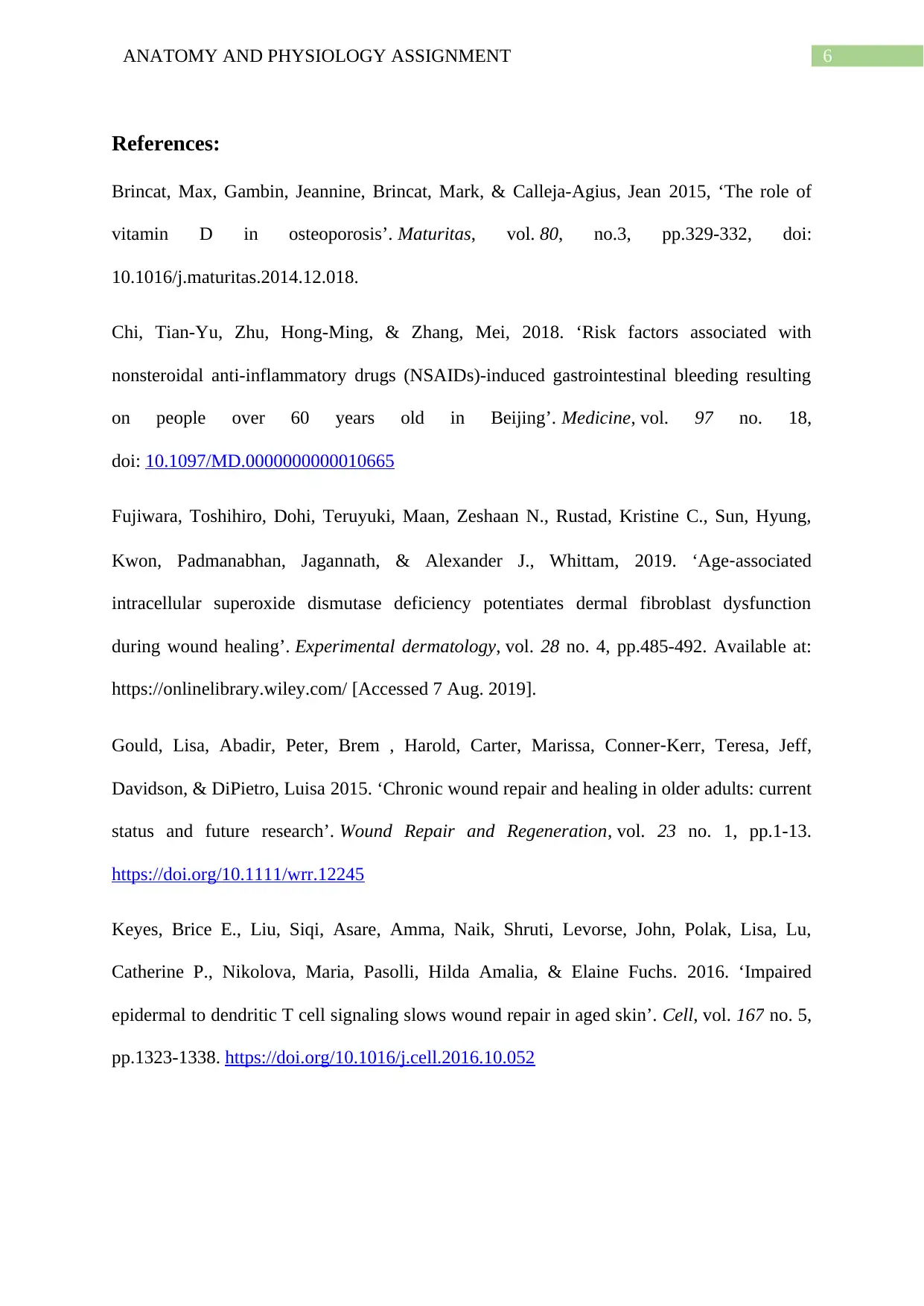
6ANATOMY AND PHYSIOLOGY ASSIGNMENT
References:
Brincat, Max, Gambin, Jeannine, Brincat, Mark, & Calleja-Agius, Jean 2015, ‘The role of
vitamin D in osteoporosis’. Maturitas, vol. 80, no.3, pp.329-332, doi:
10.1016/j.maturitas.2014.12.018.
Chi, Tian-Yu, Zhu, Hong-Ming, & Zhang, Mei, 2018. ‘Risk factors associated with
nonsteroidal anti-inflammatory drugs (NSAIDs)-induced gastrointestinal bleeding resulting
on people over 60 years old in Beijing’. Medicine, vol. 97 no. 18,
doi: 10.1097/MD.0000000000010665
Fujiwara, Toshihiro, Dohi, Teruyuki, Maan, Zeshaan N., Rustad, Kristine C., Sun, Hyung,
Kwon, Padmanabhan, Jagannath, & Alexander J., Whittam, 2019. ‘Age‐associated
intracellular superoxide dismutase deficiency potentiates dermal fibroblast dysfunction
during wound healing’. Experimental dermatology, vol. 28 no. 4, pp.485-492. Available at:
https://onlinelibrary.wiley.com/ [Accessed 7 Aug. 2019].
Gould, Lisa, Abadir, Peter, Brem , Harold, Carter, Marissa, Conner‐Kerr, Teresa, Jeff,
Davidson, & DiPietro, Luisa 2015. ‘Chronic wound repair and healing in older adults: current
status and future research’. Wound Repair and Regeneration, vol. 23 no. 1, pp.1-13.
https://doi.org/10.1111/wrr.12245
Keyes, Brice E., Liu, Siqi, Asare, Amma, Naik, Shruti, Levorse, John, Polak, Lisa, Lu,
Catherine P., Nikolova, Maria, Pasolli, Hilda Amalia, & Elaine Fuchs. 2016. ‘Impaired
epidermal to dendritic T cell signaling slows wound repair in aged skin’. Cell, vol. 167 no. 5,
pp.1323-1338. https://doi.org/10.1016/j.cell.2016.10.052
References:
Brincat, Max, Gambin, Jeannine, Brincat, Mark, & Calleja-Agius, Jean 2015, ‘The role of
vitamin D in osteoporosis’. Maturitas, vol. 80, no.3, pp.329-332, doi:
10.1016/j.maturitas.2014.12.018.
Chi, Tian-Yu, Zhu, Hong-Ming, & Zhang, Mei, 2018. ‘Risk factors associated with
nonsteroidal anti-inflammatory drugs (NSAIDs)-induced gastrointestinal bleeding resulting
on people over 60 years old in Beijing’. Medicine, vol. 97 no. 18,
doi: 10.1097/MD.0000000000010665
Fujiwara, Toshihiro, Dohi, Teruyuki, Maan, Zeshaan N., Rustad, Kristine C., Sun, Hyung,
Kwon, Padmanabhan, Jagannath, & Alexander J., Whittam, 2019. ‘Age‐associated
intracellular superoxide dismutase deficiency potentiates dermal fibroblast dysfunction
during wound healing’. Experimental dermatology, vol. 28 no. 4, pp.485-492. Available at:
https://onlinelibrary.wiley.com/ [Accessed 7 Aug. 2019].
Gould, Lisa, Abadir, Peter, Brem , Harold, Carter, Marissa, Conner‐Kerr, Teresa, Jeff,
Davidson, & DiPietro, Luisa 2015. ‘Chronic wound repair and healing in older adults: current
status and future research’. Wound Repair and Regeneration, vol. 23 no. 1, pp.1-13.
https://doi.org/10.1111/wrr.12245
Keyes, Brice E., Liu, Siqi, Asare, Amma, Naik, Shruti, Levorse, John, Polak, Lisa, Lu,
Catherine P., Nikolova, Maria, Pasolli, Hilda Amalia, & Elaine Fuchs. 2016. ‘Impaired
epidermal to dendritic T cell signaling slows wound repair in aged skin’. Cell, vol. 167 no. 5,
pp.1323-1338. https://doi.org/10.1016/j.cell.2016.10.052
Paraphrase This Document
Need a fresh take? Get an instant paraphrase of this document with our AI Paraphraser
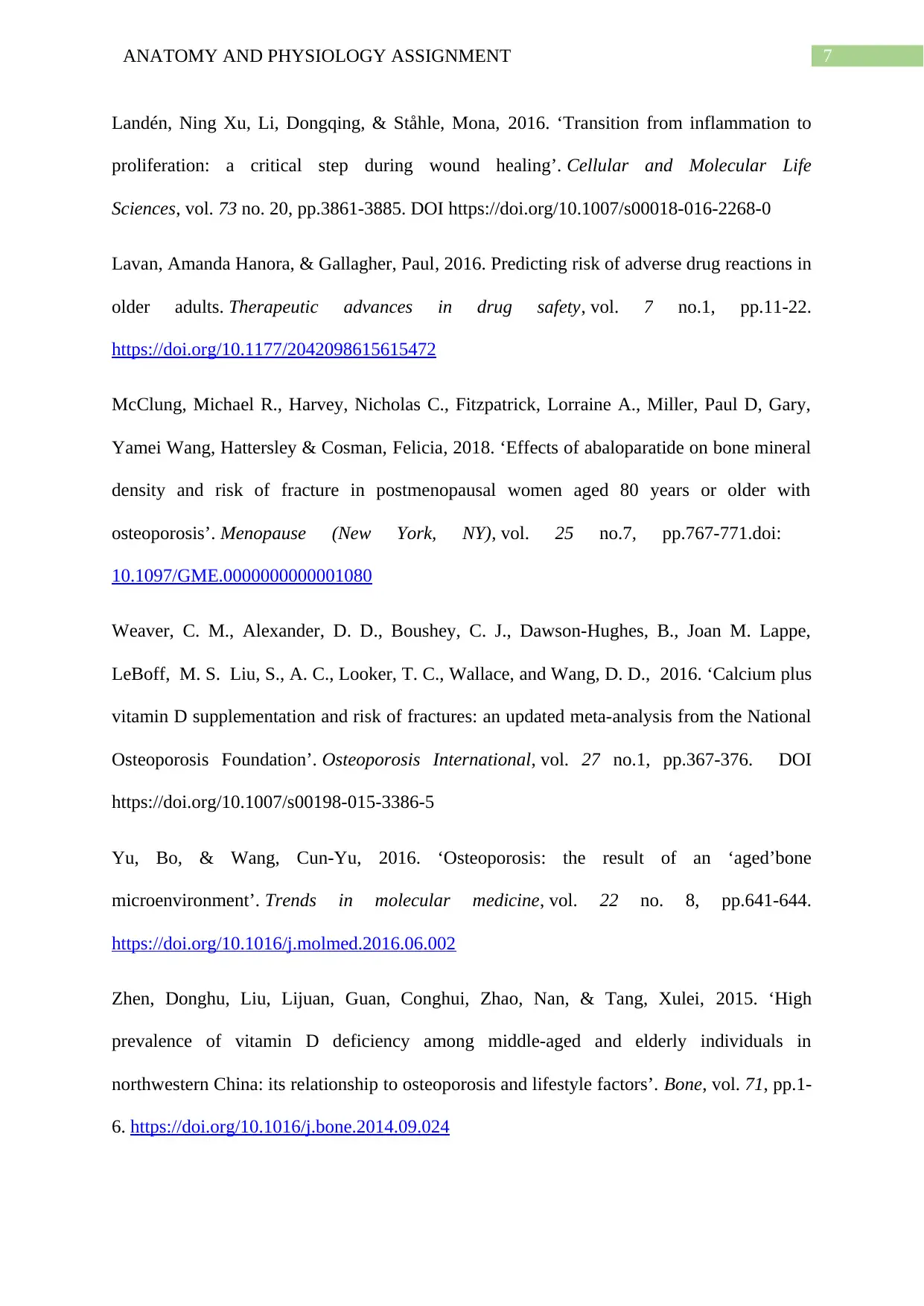
7ANATOMY AND PHYSIOLOGY ASSIGNMENT
Landén, Ning Xu, Li, Dongqing, & Ståhle, Mona, 2016. ‘Transition from inflammation to
proliferation: a critical step during wound healing’. Cellular and Molecular Life
Sciences, vol. 73 no. 20, pp.3861-3885. DOI https://doi.org/10.1007/s00018-016-2268-0
Lavan, Amanda Hanora, & Gallagher, Paul, 2016. Predicting risk of adverse drug reactions in
older adults. Therapeutic advances in drug safety, vol. 7 no.1, pp.11-22.
https://doi.org/10.1177/2042098615615472
McClung, Michael R., Harvey, Nicholas C., Fitzpatrick, Lorraine A., Miller, Paul D, Gary,
Yamei Wang, Hattersley & Cosman, Felicia, 2018. ‘Effects of abaloparatide on bone mineral
density and risk of fracture in postmenopausal women aged 80 years or older with
osteoporosis’. Menopause (New York, NY), vol. 25 no.7, pp.767-771.doi:
10.1097/GME.0000000000001080
Weaver, C. M., Alexander, D. D., Boushey, C. J., Dawson-Hughes, B., Joan M. Lappe,
LeBoff, M. S. Liu, S., A. C., Looker, T. C., Wallace, and Wang, D. D., 2016. ‘Calcium plus
vitamin D supplementation and risk of fractures: an updated meta-analysis from the National
Osteoporosis Foundation’. Osteoporosis International, vol. 27 no.1, pp.367-376. DOI
https://doi.org/10.1007/s00198-015-3386-5
Yu, Bo, & Wang, Cun-Yu, 2016. ‘Osteoporosis: the result of an ‘aged’bone
microenvironment’. Trends in molecular medicine, vol. 22 no. 8, pp.641-644.
https://doi.org/10.1016/j.molmed.2016.06.002
Zhen, Donghu, Liu, Lijuan, Guan, Conghui, Zhao, Nan, & Tang, Xulei, 2015. ‘High
prevalence of vitamin D deficiency among middle-aged and elderly individuals in
northwestern China: its relationship to osteoporosis and lifestyle factors’. Bone, vol. 71, pp.1-
6. https://doi.org/10.1016/j.bone.2014.09.024
Landén, Ning Xu, Li, Dongqing, & Ståhle, Mona, 2016. ‘Transition from inflammation to
proliferation: a critical step during wound healing’. Cellular and Molecular Life
Sciences, vol. 73 no. 20, pp.3861-3885. DOI https://doi.org/10.1007/s00018-016-2268-0
Lavan, Amanda Hanora, & Gallagher, Paul, 2016. Predicting risk of adverse drug reactions in
older adults. Therapeutic advances in drug safety, vol. 7 no.1, pp.11-22.
https://doi.org/10.1177/2042098615615472
McClung, Michael R., Harvey, Nicholas C., Fitzpatrick, Lorraine A., Miller, Paul D, Gary,
Yamei Wang, Hattersley & Cosman, Felicia, 2018. ‘Effects of abaloparatide on bone mineral
density and risk of fracture in postmenopausal women aged 80 years or older with
osteoporosis’. Menopause (New York, NY), vol. 25 no.7, pp.767-771.doi:
10.1097/GME.0000000000001080
Weaver, C. M., Alexander, D. D., Boushey, C. J., Dawson-Hughes, B., Joan M. Lappe,
LeBoff, M. S. Liu, S., A. C., Looker, T. C., Wallace, and Wang, D. D., 2016. ‘Calcium plus
vitamin D supplementation and risk of fractures: an updated meta-analysis from the National
Osteoporosis Foundation’. Osteoporosis International, vol. 27 no.1, pp.367-376. DOI
https://doi.org/10.1007/s00198-015-3386-5
Yu, Bo, & Wang, Cun-Yu, 2016. ‘Osteoporosis: the result of an ‘aged’bone
microenvironment’. Trends in molecular medicine, vol. 22 no. 8, pp.641-644.
https://doi.org/10.1016/j.molmed.2016.06.002
Zhen, Donghu, Liu, Lijuan, Guan, Conghui, Zhao, Nan, & Tang, Xulei, 2015. ‘High
prevalence of vitamin D deficiency among middle-aged and elderly individuals in
northwestern China: its relationship to osteoporosis and lifestyle factors’. Bone, vol. 71, pp.1-
6. https://doi.org/10.1016/j.bone.2014.09.024
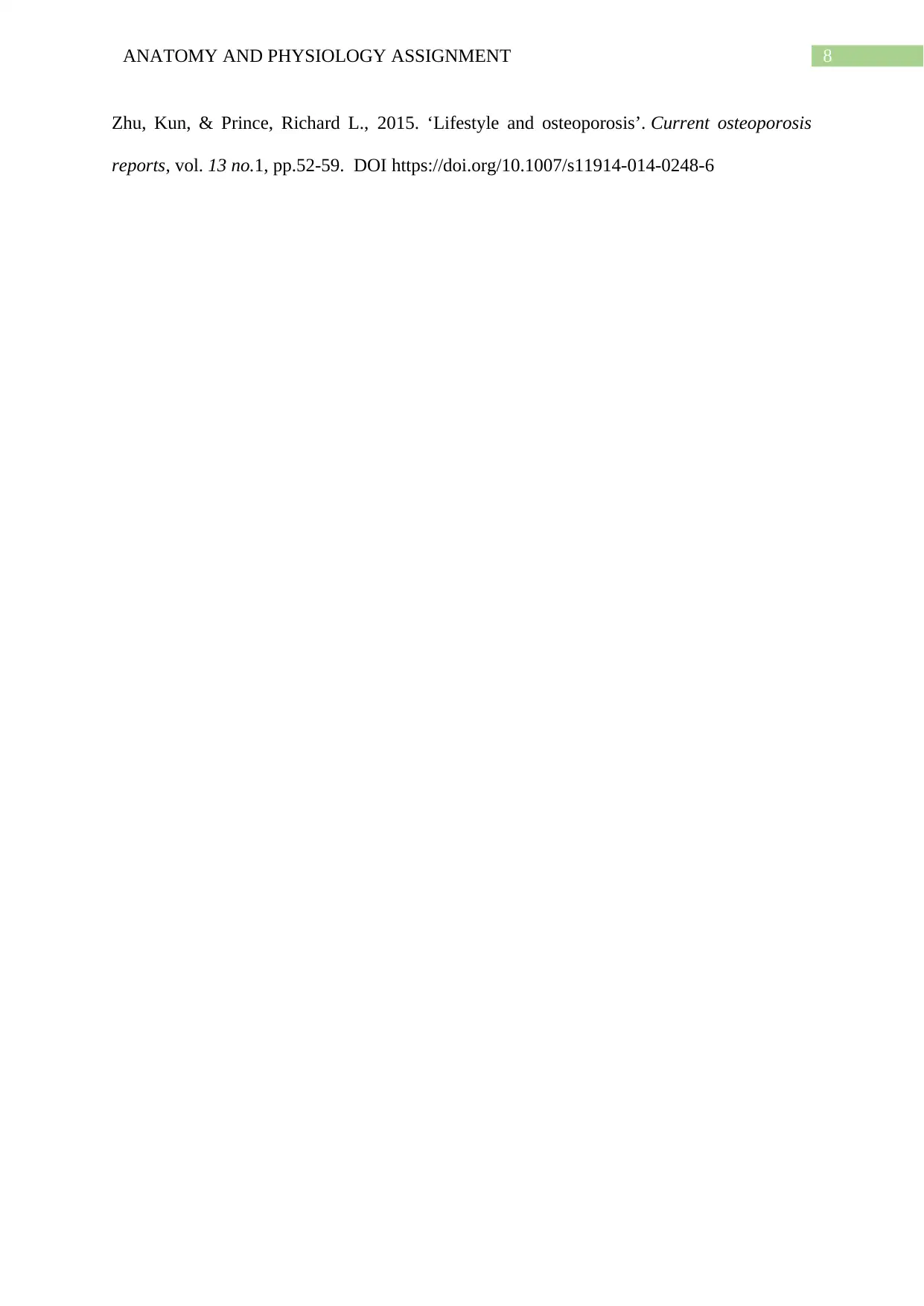
8ANATOMY AND PHYSIOLOGY ASSIGNMENT
Zhu, Kun, & Prince, Richard L., 2015. ‘Lifestyle and osteoporosis’. Current osteoporosis
reports, vol. 13 no.1, pp.52-59. DOI https://doi.org/10.1007/s11914-014-0248-6
Zhu, Kun, & Prince, Richard L., 2015. ‘Lifestyle and osteoporosis’. Current osteoporosis
reports, vol. 13 no.1, pp.52-59. DOI https://doi.org/10.1007/s11914-014-0248-6
1 out of 9
Related Documents
Your All-in-One AI-Powered Toolkit for Academic Success.
+13062052269
info@desklib.com
Available 24*7 on WhatsApp / Email
![[object Object]](/_next/static/media/star-bottom.7253800d.svg)
Unlock your academic potential
© 2024 | Zucol Services PVT LTD | All rights reserved.





